In 2019 I sold a site in the pet niche for 6 figures. There are many reasons this site earned me almost half a million dollars over the 3+ years I owned it, including great links, private affiliate offers, and high-earning ad platforms.
Perhaps the biggest reason for its success was my content strategy, including the two content audits I performed, first in January 2018, then again in October of that year.
The first audit took it from stagnation to five figures per month.
The second audit reversed the negative effects of a Google algorithm update.
Below, I’ll break down exactly what I did, and how you can do the same.
What is a content audit, and when should you do one?
I’ll admit that I’m as guilty as the next SEO when it comes to hitting things with my link building hammer.
You publish decent content, and then every challenge thereafter becomes a nail.
Adding new content, but seeing traffic remains the same? It must be an authority issue. Get more backlinks!
Algorithm update pushes sites like Business Insider above yours for keywords they have no business ranking for? …you guessed it, get more backlinks!
But in the days of search intent and NLP, not every traffic problem really is a nail. Believing so is a sure-fire way to drive yourself crazy and end up writing depressing Medium posts about how SEO and link building are dead.
Assuming you’ve covered the basics, that you’ve got a reasonable set of relevant, authoritative links, and that there are no glaring technical issues holding you back, performing and acting on a content audit is one of the best ways to diagnose and fix a site stuck in the SERPs.
A content audit gives you a 30,000-foot view of your website, and allows you to craft a holistic approach to improving it to meet Google’s expectations, specifically when your site has been stagnant for months and/or your share of search has been negatively impacted by an algorithm update.
Your output goal here is three-fold:
- Update underperforming content to meet current best-practices and search intent
- Remove irrelevant and thin content
- Add relevant supporting content
Here are the basic steps you’ll follow:
- Pull all of your content data into a spreadsheet
- Identify underperforming or negatively impacted content
- Identify overall themes and silos that exist in your content
- Analyze the top-ranking content for your target topic(s)
- Edit, remove, or rewrite existing content to put it more in line with what Google expects to see for pages it rewards
- Build a content calendar to fill in any gaps in your site
Content audit results
Here is a traffic graph, showing pageviews and when I performed the content audits that I’ll be describing below.
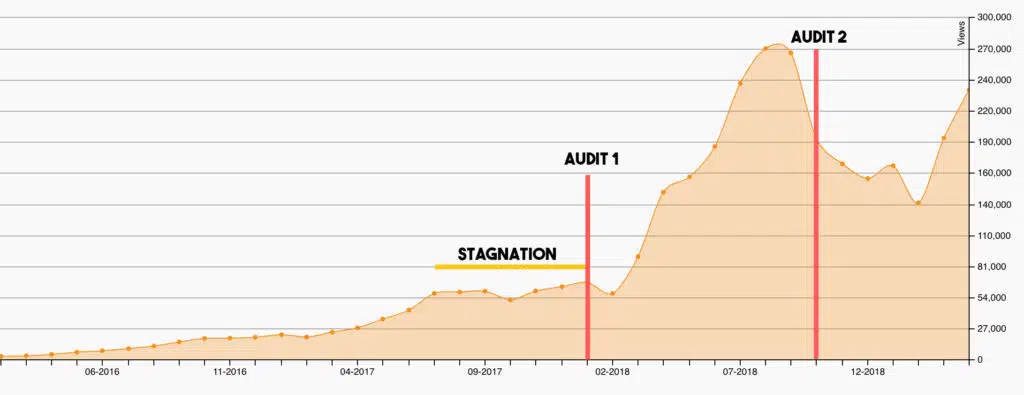
Audit 1: January 2018
Main issue: Stagnant traffic and earnings, even though content and links were being added.
Work performed: Updated 273 posts over 3 months. Some completely overhauled, some with nothing more than a minor title adjustment.
Result: Traffic went from about 60,000 pageviews per month to 270,000 by August 2018
The biggest issue with this site the first time I audited my content was that we were missing very basic elements of successful SEO content.
Here are some of the issues we fixed:
- Optimized Title and Headers for keyword variations and qualifier keywords (best, review, etc.), and for CTR
- Added main keyword(s) to articles where they were either missing or under-optimized
- Improved word count by matching the average on page 1 of Google (adding words to short articles, and breaking up ultimate guides into smaller posts)
- Updated inner links for relevancy, and added inner links to older pages that had none
- Removed or redirected pages that were targeting the same keyword as another, better page
- Added missing alt tags
- Improved User Experience (UX), specifically by breaking up big blocks of text into shorter paragraphs, and adding multimedia where appropriate.
Naturally, there was probably a lot more going on here, but this is what we focused on, and it worked.
I believe we got the biggest boost to pages that were seriously under-optimized.
Up until this point I had considered “playing it safe” the only way to be sheltered from future algorithm updates.
Unfortunately, I took it way too far. Many of our pages didn’t even include mentions of our target keyword outside of the title. They were also missing mentions of similar, related keywords that Google would expect to see on pages on a particular topic.
Most of the work focused on adding mentions of relevant keywords to each piece of content. We would find what keywords the top-ranking pages also ranked for in Ahrefs, and add some of those to the body content and the headers.
As an example, if we had a page titled “Sphynx Cats”, we would edit it to become “Sphynx Cat Facts: Origins, Colors, Health Issues, & Nutrition”. We’d then add sections within the article talking about these points. This allowed us to rank for a lot more long-tail keywords, and also get more click-throughs from the SERPs.
I last updated my audit spreadsheet in April, at which point 218 articles were significantly up, 15 were down, and traffic remained neutral on 4. The rest were either redirected to a similar article to fight cannibalization, removed, or we were still running tests on.
Audit 2: October 2018
Main issue: Negatively affected by a Google Algorithm Update, causing a traffic decline.
Work performed: Created site-wide relevancy by updating over 300 of our 467 posts. We updated content to match search intent and ensured each topic was properly siloed.
Result: Traffic went from a low of 136,000 pageviews in February to 235,000 in April.
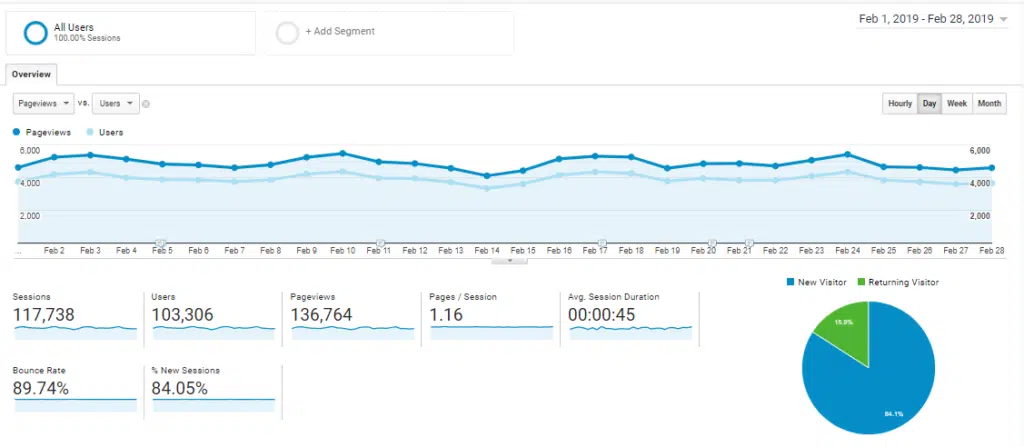
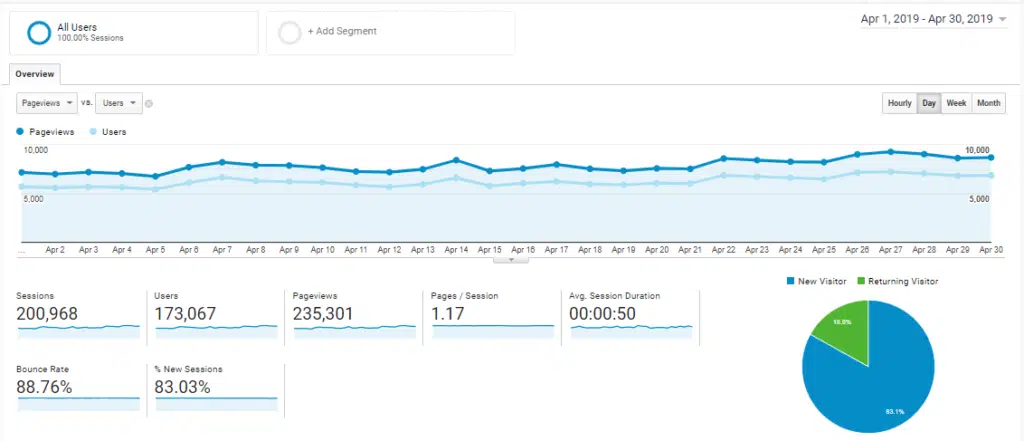
February 2019- April 2019
The biggest issue we found in our second audit was that a lot of our content was out of line with what Google was expecting. The articles didn’t match the search intent for their main keywords.
This happened one of two ways:
- Our content simply didn’t answer the question in an authoritative way, and missed many of the topics that a searcher would care about when looking for an answer to their query.
- Our content type was wrong. Google’s update seemed to focus on tightening relevancy, so 10,000-word Ultimate Guides that covered reviews of every single type of cat food, for example, were too broad.
Here are some of the issues we fixed:
- Matched content to search intent
- Ensured all content actually answered the main query succinctly and at the top of the page
- Broke up “Ultimate Guide” type articles into multiple smaller guides targeting specific sub-topics
- Changed inner links to target the same silo/category more often, and turned some pages into Hub Pages, linking out to relevant sub-topics
- Removed or redirected pages that hadn’t got more than 10 organic visits over the last 3 months
This update focused much more on the overall site and topic relevancy, rather than ensuring we had the basics covered and a keyword on each page.
This is when we noticed that topics were becoming more important than keywords, and that we needed to become a lot more thoughtful in our content production in order to genuinely serve Google’s users.
How to perform an SEO content audit in 2020
Content Audit Template
Here’s a copy of our Google Sheets content audit template so you can follow along.
Download TemplateWhen I do content audits these days, I combine all of the above steps, and of course, streamline as much as possible. We’ve also started using more advanced tools to get to the heart of what Google wants.
Keep in mind that this is almost exclusively an on-page content audit, and not a technical content audit. For Wordpress content-based sites under 1000 pages, this should give you everything you need. However, if your site is large or highly technical, you’ll likely need to add other data points (from Screaming Frog or Google Search Console, for example) to your audit.
Feel free to add any other data you need. For example, if your site is more complex and/or you’re dealing with redirects or other status issues, you will likely need to export data from Screaming Frog.
Here’s a step by step guide to auditing your site to get more traffic.
Step 1: Downloading your data into a spreadsheet
First, you’ll need to export all of your current content data from Google Analytics.
Go to Acquisition > Channels > Organic Search, then select Primary Dimension = Landing Page.
Then, go to Export, and choose CSV. Copy the relevant columns and paste into Google Sheets or Excel.

Next, I like to pull in some data from Ahrefs (you could use SEMRush here), including:
- # of Keywords a page is ranking for
- Main Keyword
- Main Keyword position
- Main Keyword volume
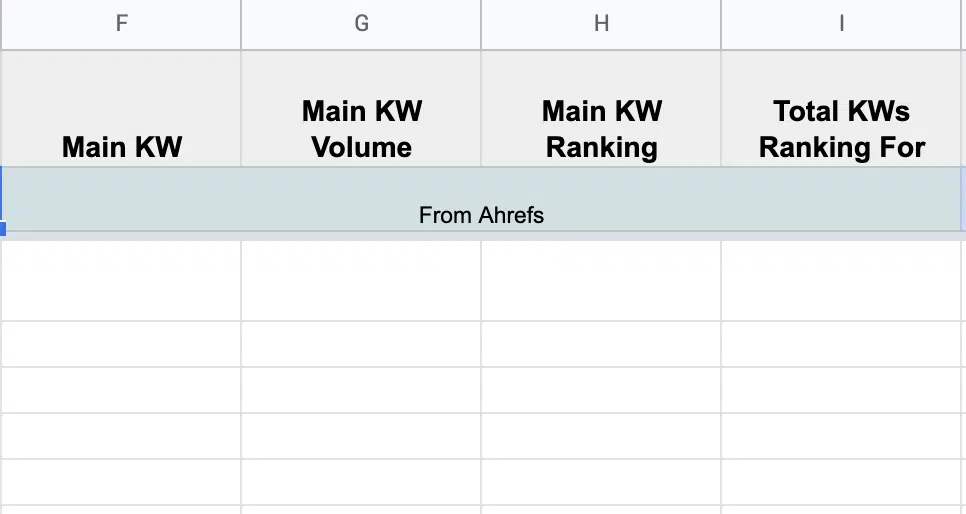
The spreadsheet I use automatically pulls Title and H1 values into the spreadsheet using an =IMPORTXML function in Google Sheets.
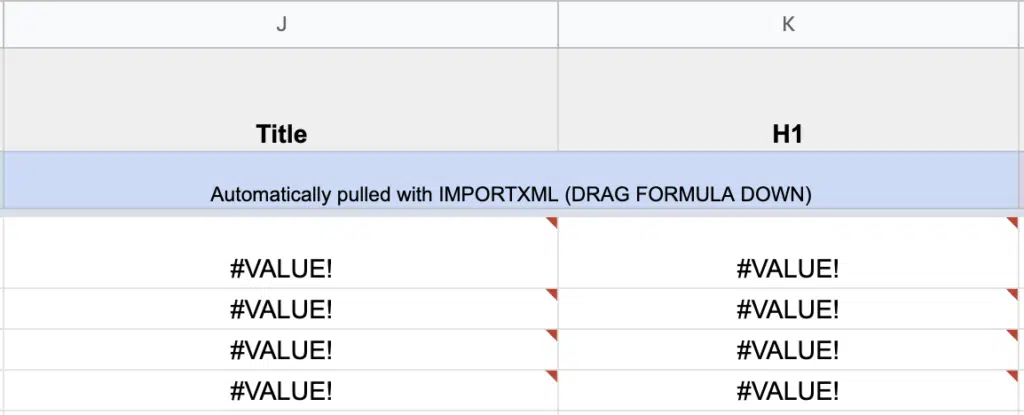
I’ll then add the published date and the word count.
Next comes some manual data entry.
Categorize each article by the category or silo that it fits within. For example, my cat website had silos like:
- Food
- Health
- Names
The final piece of the puzzle is running a Clearscope report for each page. Clearscope is a paid tool, but in my opinion, it is vital to get a full picture of what Google expects to see from a page ranking on Page 1.
While you can perform a content audit without Clearscope, it just takes more time, and your work is going to be less accurate.
Without Clearscope, you’d need to manually analyze Page 1, finding things like Content Type, Word Count, Headers, Phrases Used, and more.
I performed my first content audit without Clearscope, and about half of my second audit without Clearscope, so there’s still a lot you can do without it.
But thanks to Clearscope’s use of IBM’s Watson and Google’s NLP, not using it is like bringing a knife to a gunfight.
I’ll add the Clearscope report link to the Audit Spreadsheet, run my content through their Optimize function, enter the current Clearscope grade in the spreadsheet, enter the most prominent Content Type, and enter word counts for both my page and the average of the top-ranking pages.
I’ve added a formula to calculate the percent difference in word count between my article and the top 10 in Google, and another formula which tells me when my content is 25% shorter or longer than the average.
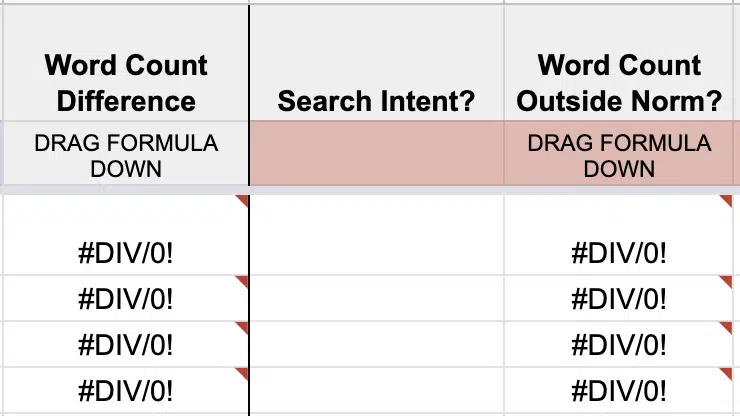
Word count is not usually the cause of your ranking issues, but if something’s way off, it’s nice to have a quick filter to use to see where you might be out of line.
Step 2: Identifying underperforming, thin, and irrelevant content
Now it’s time for the content analysis to begin.
The first column of the spreadsheet is the Status column. This is where we’ll break down the work that needs to be done.
I like to break this down as follows:
Good
The article is high quality, the search intent is correct, on-page signals like inner links are set, and there doesn’t appear to be anything majorly wrong with the article. No content work needs to be done.
Edit
The article is pretty good, the search intent is correct, but it requires some light edits, like adding inner links, updating the Title or Headers, making the answer to the query more succinct and clear on the page, or adding a content upgrade (like a PDF download).
Rewrite (Intent)
The search intent is incorrect, and the article needs to be rewritten to match the intent.
For example, if you are targeting the keyword “keto ketchup”, and your current blog post is an article (you describe what keto ketchup is, whether it’s actually keto, where to buy it, etc.), you are not targeting the correct search intent.
Looking at Page 1 of Google for this term, we see that Google believes people either want to know how to make keto ketchup, or want to buy keto ketchup.
An article that simply talks about the facts of keto ketchup will never rank for this query, and you should rewrite your article as a recipe.
Rewrite (Quality)
The search intent is correct, but the article is low quality.
Low quality in this case can mean obviously poor writing, thin content, bloated content, or a low Clearscope grade.
You should rewrite your article and aim to get an A+ grade in Clearscope, or at least increase the quality of your writers.
Redirect
The search intent and article quality are fine, but this page is competing with another, more important page on your website.
If it is so closely related that you can’t edit it to target a unique topic, and that it makes sense for the reader of this page to consume your more important page, you can 301 redirect it to the more important page.
Remove
This article is either irrelevant to the overall theme of your blog, or is outdated and can’t be updated, or is otherwise not serving your audience.
To preserve topical relevancy in the eyes of Google, you can remove this post.
In order to select a Status, you will likely have to both visit and examine both your page and the SERPs, either manually or by using Clearscope.
Pages that are getting a lot of traffic or ranking in the top 3 for your target keyword typically get marked Good, because unless the SERP relies on freshness, you’re probably doing things mostly right here.
One extra step you can take to ensure your “Good” articles really are good, is to compare search traffic with the other pages ranking on Page 1 in Ahrefs. If you’re getting 1000 visits per month, but everyone else on Page 1 is getting 4000+, for example, you may be missing some important longtail sections in your article.
For pages underperforming from a traffic or keyword ranking standpoint, you’ll need to go through and try to diagnose the problem, and then mark down exactly what you think needs to be fixed.
Here is what I look for:
- Are the page title tag and H1 optimized for both keywords and CTR?
- Was this post published a long time ago? Does the SERP favor freshness? Is the page still meeting search intent? Has your competition greatly improved since publishing?
- Is the Clearscope grade A- or lower?
- Is there a significant word count difference between the page and the top 10 average?
- Is the content the right type for the SERP? (Am I trying to rank an article when Google expects a video?)
- Does the post match search intent?
- Does the post contain inner links to other relevant pages in its silo?
- Does the post have inner links coming to it from other relevant pages in its silo?
- Are the basics covered? (Alt tags, proper use of headers, key phrases included, etc.)
- Is the UX good enough? (No big blocks of text, multimedia when applicable, ads not overwhelming, etc.)
This process takes time, but can produce massive results, as I shared above.
Once you’ve gone through each page to diagnose what you think might be the problem, and chosen a Status for each page, you’ll be more likely to determine whether it’s a broad site-relevancy issue or if your posts are simply not good enough.
While simplistic and difficult to systemize, the overarching principle here is to look at your site from a visitor’s perspective. Is your content really good enough to be ranking on Page 1 and does it serve the needs and search intent of a searcher?
If the content is just “OK”, if the UX is clunky, if it looks outdated, if there are no links to reputable sources, if you don’t mention important phrases and topics in your post that experts would mention, if you’re missing the basics…you probably don’t deserve to rank, no matter how many off-page authority signals you’re sending.
Step 3: Editing, rewriting, and producing new content
Now that you’ve given each post a status, it’s time to get to work. Start with your most important pages, and then work down the list.
If you’re not experienced making updates to existing content, you might choose to make small edits to a handful of pages, and see what happens.
If you see results, you can move forward with more changes, knowing that you’re on the right track.
If you’re a more experienced SEO and are confident in your diagnostic abilities, you can tackle a larger portion of the site.
Be aware that the work itself can take months, and the results can take anywhere from a few days to a few months, if you’re successful.
Editing and rewriting should be fairly straightforward now that you have your audit spreadsheet filled out, so I’ll mention one last thing regarding new content creation.
If, during the content auditing process, you discover that your site has thin categories or silos, you may want to prioritize the filling of these gaps by adding them to your content calendar.
For example, during my second content audit, I realized that our most important page, which reviewed cat food, was poorly supported.
We originally included so much information in this one giant article that we never created supporting content around it, because we were worried about cannibalization.
What we ended up doing was significantly shortening the main cat food review page, and creating 10+ new articles related to cat food. The original page ended up acting like a hub or pillar page, as it linked to each of the new supporting pages, and vice versa.
The original page saw a slight increase in traffic, and each of the new supporting pages we created brought in even more highly targeted new traffic.
Content audits are a vital part of SEO and content marketing
Hopefully, you now understand just how important content audits can be to your overall content strategy and the growth of your website.
I now perform regular content audits of my properties, even when things seem to be going well.
It’s one of the biggest reasons I was able to increase a recent client’s Google traffic by 2,287% in 4 months.
Search engine algorithms change daily, and updating your content inventory a couple of times per year can yield big dividends and keep you ahead of the curve.
Learn more about content strategy
Check out our Content Strategy course to learn even more about running content audits, planning and executing on content campaigns, and how to find quick wins with existing content.
View our Content Strategy Course